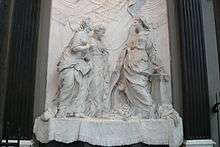Jan Baptist Xavery
Jan Baptist Xavery (born Antwerp, 30 March 1697 - died The Hague, 19 July 1742) was an 18th-century Flemish sculptor principally active in the Netherlands.
Biography

He was the son of the sculptor Albertus Xavery, who probably taught him before he entered the studio of Michiel van der Voort. There he stayed until moving to Vienna in 1719; from there he went to Italy, returning in 1721 and settling in The Hague. In 1725 he became a member of that city's painters' guild, the Confrerie Pictura. Also in 1725 he married Maria Christina Robart, with whom he had two sons, Frans and Jacob; both would go on to become painters. In 1729 he became court sculptor to William IV of Orange-Nassau. There is some evidence, too, that he worked briefly around 1737 for Frederick I, Landgrave of Hesse-Kassel. Xavery died in 1742.
Xavery was likely related to the sculptor Pieter Xavery.[1] His brother Gerard Joseph was also a painter. His pupil was Willem Hendrik van der Wall.[2]
Style
Stylistically, Xavery was influenced at the start of his career by Daniel Marot; later, his style became more elaborate, in works such as the Allegory of Faith of 1735-9, in the Grote Kerk of Haarlem.[1]
References
- 1 2 Iris Kockelbergh. "Xavery, Jan Baptist." Grove Art Online. Oxford Art Online. Oxford University Press. Web. 1 Mar. 2014.
- ↑ Jan Baptist Xavery in the RKD
| Wikimedia Commons has media related to Jan Baptist Xavery. |